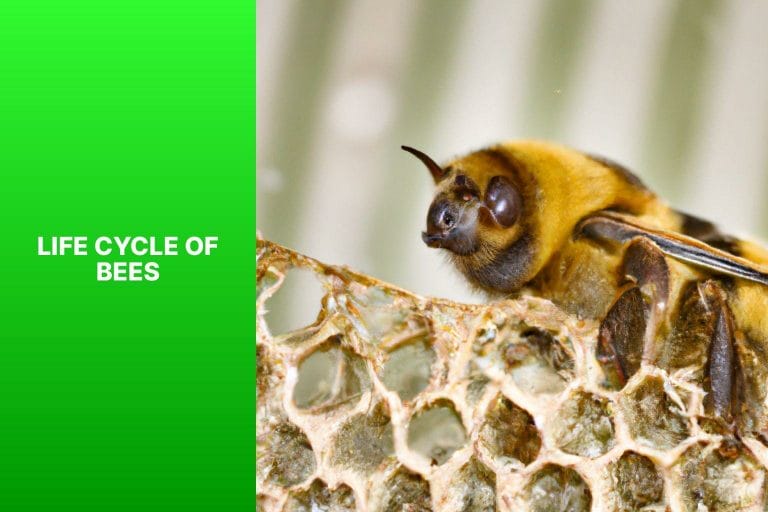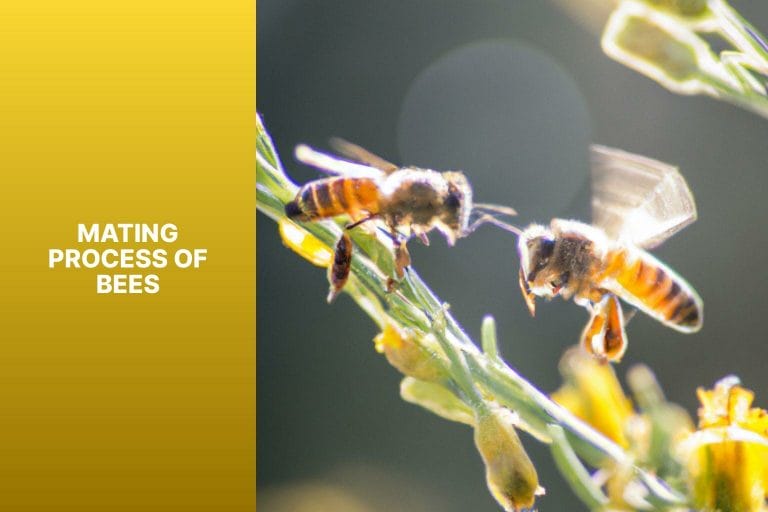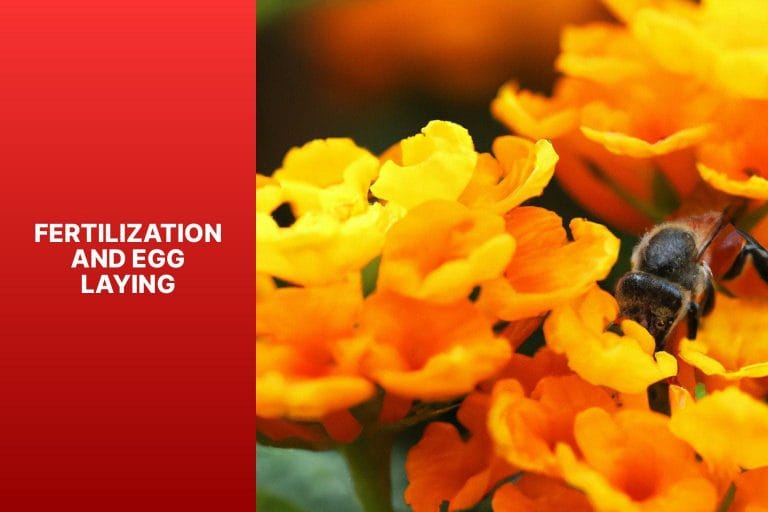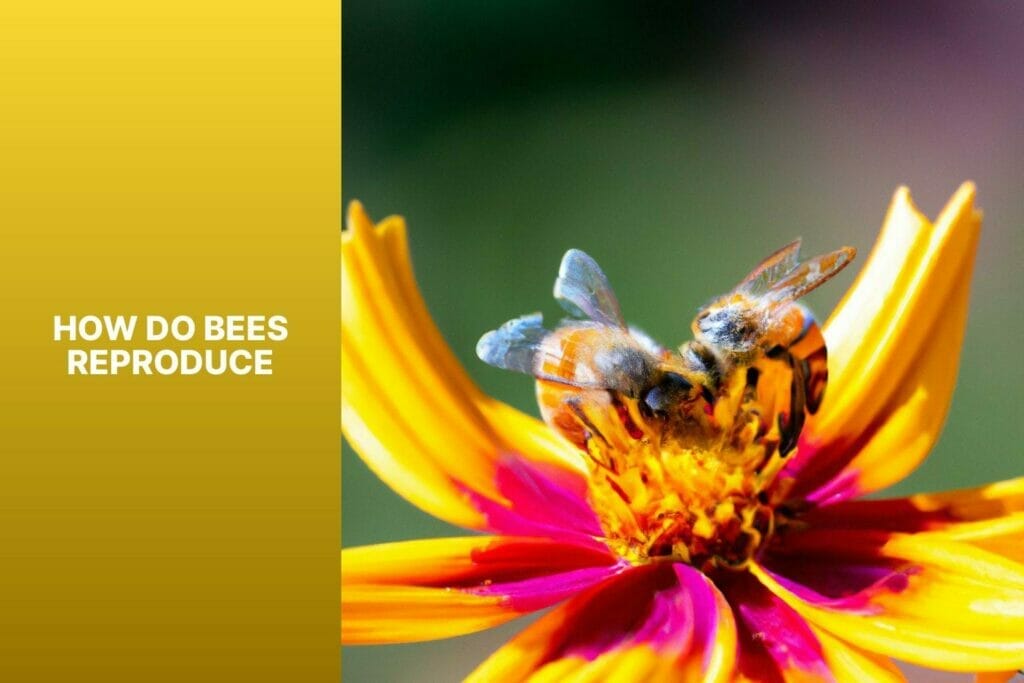Bee reproduction is a fascinating process that plays a crucial role in the survival and continuation of their species. Understanding how bees reproduce can provide valuable insights into their life cycle and their roles within their colonies.
A study by Scientific Beekeeping offers a comprehensive overview of bee reproduction.
The life cycle of bees consists of four stages: the egg stage, larva stage, pupa stage, and adult bee stage. Each stage brings about unique changes and developmental milestones.
From the moment an egg is laid by the queen bee to the final emergence of an adult bee, this cycle is a testament to the intricate nature of bee reproduction.
Different bees have specific roles in the reproduction process within a bee colony. The queen bee is responsible for laying eggs, while drone bees are male bees that serve a crucial purpose in mating.
On the other hand, Worker bees contribute to the overall functioning of the colony but do not participate directly in reproduction.
The mating process of bees involves specific behaviors and flight patterns. The queen bee embarks on a mating flight and mates with multiple drones. The behavior of drone bees is focused on finding and mating with a queen to ensure the survival of their genetic material.
After mating, fertilization occurs within the queen bee’s body, and she lays fertilized eggs. The egg-laying process is a critical step in continuing the bee population. The fertilized eggs are deposited into cells within the honeycomb, where they undergo further development.
The development of bee larvae within the honeycomb is a miraculous process. The larvae receive nourishment from worker bees as they grow and undergo various transformations.
With time, the larvae go through the pupa stage, during which they undergo metamorphosis and eventually emerge as adult bees ready to contribute to the colony.
Understanding the intricate process of bee reproduction sheds light on the incredible complexity of their life cycle and emphasizes the crucial roles each bee plays in this process.
Bee reproduction is vital for the survival and sustainability of these remarkable pollinators, highlighting their importance in the ecosystem and the need for their conservation.
Key takeaway:
- Bee reproduction is a complex process involving different stages: Bees go through the stages of egg, larva, pupa, and adult bee, each with unique characteristics.
- The roles of bees in reproduction are distinct: The queen bee is responsible for reproduction, drone bees play a crucial role in mating, and worker bees support the colony in various ways.
- Mating and fertilization are essential for bee reproduction: Queen bees go on mating flights, while drones engage in specific mating behaviors. Fertilization and egg-laying processes ensure the continuation of the bee population.
- Bee reproduction involves egg, larva, pupa, and adult bee stages.
- The queen bee leads reproduction, while drones assist in mating.
- Mating, fertilization, and egg-laying are critical for bee population growth.
Life Cycle of Bees

Photo Credits: Savethebeesproject.Com by Ronald Wilson
Bees, those tiny buzzing creatures, have a fascinating life cycle. The journey is remarkable from the moment they hatch as tiny eggs to their transformation into adult bees.
In this section, we’ll uncover bees’ different stages: the egg stage, where life begins, followed by the larva stage, a time of rapid growth and development.
We’ll also explore the mysterious pupa stage, where transformation takes place, ultimately leading to the emergence of the majestic adult bee. Get ready to delve into the captivating life cycle of bees!
Egg Stage
The Egg Stage is the first stage in a bee’s life cycle. The queen bee lays eggs in the cells of the honeycomb.
| Stage | Description |
| Egg Stage | The queen bee lays eggs in the cells of the honeycomb. |
| Larva Stage | The eggs hatch into larvae and are fed a mixture of royal jelly and pollen by worker bees. |
| Pupa Stage | The larvae spin a silk cocoon and undergo metamorphosis into pupae. |
| Adult Bee Stage | The fully developed bees emerge from their cocoons and perform various roles within the hive. |
The eggs are small and oval-shaped during the Egg Stage, usually laid individually. The queen bee’s number of eggs can vary depending on colony needs. The eggs are tiny, measuring less than a millimeter in diameter.
It is important to note that the eggs are unfertilized at this stage. They can develop into female worker bees or male drone bees, depending on fertilization. The development into a queen bee requires special feeding with royal jelly.
Once laid, worker bees care for the eggs and ensure optimal conditions for development. The duration of the Egg Stage varies based on bee type and environmental factors. This stage typically lasts about three days for honey bees before the eggs hatch into larvae.
The Egg Stage is crucial for colony reproduction and survival. It is fascinating to observe the transformation of these tiny eggs into vital members of the hive.
Larva Stage
The larva stage of bee larvae is a crucial phase in their life cycle. This stage is characterized by significant growth and development, preparing them for adulthood.
The larvae consume nutrient-rich royal jelly during the larva stage, which begins with hatching and lasts approximately six days. This diet allows them to grow rapidly, increasing their size and weight.
The larvae are carefully placed in honeycomb cells where worker bees provide warmth and protection to ensure their well-being.
Worker bees tirelessly feed and care for the larvae throughout the larva stage. The bee larvae’s future roles within the hive are determined during this period.
Interestingly, their diet plays a vital role in this determination. The larvae will become queen bees if exclusively fed royal jelly.
A diet consisting of royal jelly and honey will result in them becoming worker bees. This feeding pattern directly influences their development and the specific roles they will assume in the colony.
Pupa Stage
The Pupa Stage is a crucial part of the bee life cycle. During this stage, a larva transforms into an adult bee. Here are some key facts about the
–
The Pupa Stage follows the Larva Stage and precedes the Adult Bee Stage.
–
The pupa is inside a protective silk cocoon spun by the larva before it becomes a pupa.
–
The pupa undergoes metamorphosis inside the cocoon and develops into an adult bee.
–
During this stage, the pupa is immobile and does not eat. It relies on stored resources from earlier stages.
–
The length of the Pupa Stage varies depending on the bee species and environmental conditions. It takes about 10 to 14 days for the pupa to develop fully.
–
The pupa is completely enclosed in its cocoon, and the external features of the adult bee are not visible.
Understanding the Pupa Stage helps us appreciate the remarkable transformation that bees undergo. It showcases the development process and highlights the resilience of these important insects.
Scientists and researchers have studied the Pupa Stage to gain insights into bee reproductive biology and behavior. Their findings have contributed to our understanding of bee populations and their vital role in pollination and ecosystem health.
Adult Bee Stage
The adult bee stage is crucial in the bee life cycle, as during this stage, bees actively perform their roles to ensure the survival and growth of the colony.
Bees have different roles based on gender and responsibilities within the hive. Here is an overview of the adult bee stage:
1. Queen Bee: The largest and longest-living bee in the colony, the queen bee is responsible for laying eggs and maintaining hive harmony.
2. Drone Bees: Male bees, called drones, are larger than worker bees and have the primary purpose of mating with the queen. They do not have stingers and do not engage in other hive tasks.
3. Worker Bees: Most bees in a colony are worker bees. They are smaller than the queen and perform tasks like foraging, building combs, cleaning the hive, and feeding larvae.
The cooperation and coordination among different types of bees within the hive during the adult stage are fascinating to observe.
To make the article more engaging, readers can create a bee-friendly garden to support the adult bee stage. Providing a diverse range of flowers and avoiding pesticides can attract and support bees as pollinators.
Preserving bee populations is crucial for ecosystem health and food production.
Roles of Bees in Reproduction
Bees play crucial roles in the fascinating world of reproduction. Each has a distinct role, from the regal Queen Bee to the industrious Worker Bees and the charming Drone Bees.
In this section, we’ll take a closer look at the unique contributions of these bee counterparts, uncovering their fascinating roles in the intricate dance of bee reproduction.
So brace yourself for a journey into the buzzing world of bee procreation!
Queen Bee
The Queen Bee is crucial in bee reproduction. She maintains the population and ensures colony survival.
| Characteristics | Responsibilities |
| Much larger than worker bees | Mates with drones to fertilize eggs |
| Longer lifespan than worker bees | Lays eggs in individual honeycomb cells |
| Develops from a fertilized egg | Releases pheromones to maintain colony harmony |
| Capable of laying up to 2,000 eggs per day | Continually monitored and cared for by worker bees |
| Only one Queen Bee is present in a functioning colony | Can choose to replace or swarm when necessary |
The Queen Bee is vital for colony fertility, laying thousands of eggs. She mates with drones during the queen mating flight for genetic diversity.
Eggs are laid in honeycomb cells and develop into larvae under worker bee care. Queen Bee’s pheromones maintain harmony and hierarchy in the colony.
Without a Queen Bee, worker bees can develop a new queen by selecting and feeding a larva royal jelly. The queen bee is a fascinating and vital member of the honey bee colony.
Drone Bees
Drone bees play a crucial role in bee reproduction. They are male bees whose main purpose is to mate with the queen bee. Unlike infertile female worker bees, drone bees can reproduce.
During mating, drone bees fly out of the hive to find virgin queen bees. This is known as drone mating flight. When a drone bee finds a queen, they compete with other drones to mate.
The drone mates with the queen to fertilize her. The drone bee transfers semen to the queen, which she stores for future use in fertilizing eggs. This ensures genetic diversity in the bee colony.
Not all drone bees are successful in mating. Some are better than others at finding queens. Only a small percentage of drone bees will mate during their lifetime.
Once the mating process is complete, the drone bee’s purpose is fulfilled. They cannot gather nectar or pollen like worker bees. As a result, drone bees are often expelled from the hive during scarcity or winter.
Worker Bees
Worker bees, also known as female bees, play a crucial role in the reproduction of bees. These worker bees have a wide range of responsibilities within the bee colony.
One of their main tasks is gathering nectar and pollen from flowers and returning them to the hive. This nectar and pollen feed the entire colony, including the queen and the larvae.
In addition to collecting food, worker bees are responsible for constructing and maintaining the hive. They create various structures within the hive for egg-laying and food storage.
In collaboration with the queen, they assist in laying eggs and ensuring her comfort and safety. Worker bees are involved in regulating the hive’s temperature, which is crucial for the optimal growth of the brood.
Worker bees have distinct roles within the colony and are highly organized. Their diligent and coordinated efforts are essential for the survival and reproduction of the entire bee community.
On the other hand, male bees, referred to as drones, cannot perform these reproductive tasks.
Mating Process of Bees

Photo Credits: Savethebeesproject.Com by Henry Thomas
Did you know that the mating process of bees is a fascinating topic? This section explores the mysterious and intricate world of bee reproduction.
We’ll delve into two intriguing sub-topics: the intense queen mating flight and the curious drone mating behavior. Brace yourself for some surprising facts and interesting insights into the intriguing world of bee reproduction!
Queen Mating Flight
The queen mating flight, a crucial stage in bee reproduction, involves the queen bee leaving the hive to mate with male drones. Several important details surround the queen mating flight:
- The queen bee engages in mating shortly after attaining sexual maturity.
- For protection and guidance, worker bees accompany the queen during the flight.
- Queen mating flights take place on warm, sunny days with favorable conditions.
- The queen releases pheromones during the flight to attract drones from other colonies.
- Pursuing the queen during her flight are multiple drones from different colonies.
- After mating, the queen stores the drones’ sperm in the spermatheca.
- Following a successful mating flight, the queen returns to the hive and assumes the role of the reproductive center of the colony.
Maintenance of genetic diversity in bee populations relies heavily on the queen mating flight. By mating with drones from various colonies, the queen ensures a healthy and diverse gene pool within the hive.
This diversity is essential for the survival and adaptability of the bee population.
Drone Mating Behavior
Drone mating behavior plays a vital role in bee reproduction. Male bees, known as drones, venture out of their hive to gather in specific drone congregation areas during the mating season.
In these areas, they patiently await the arrival of a virgin queen bee. Once the queen bee is prepared for mating, she takes flight toward the drone congregation area and emits pheromones to attract the attention of the drones.
Upon detecting the queen’s pheromones, the drones engage in competitive and aggressive behavior, vigorously pursuing the queen bee. Only a select few drones are successful in mating, as the queen mates exclusively with them.
Once the mating is complete, a tragic fate awaits the drones, as their reproductive organs are ripped from their bodies, causing their demise.
The drone mating behavior holds immense significance in the survival of bee colonies as it ensures genetic variation within the hive. By mating with drones from different colonies, the queen bee prevents inbreeding and enhances the overall health and resilience of the bee population.
It might surprise you that a single queen bee can mate with multiple drones in a single flight during the mating season. This extraordinary ability allows her to obtain enough sperm for fertilizing eggs and continue laying for her life.
Fertilization and Egg Laying

Photo Credits: Savethebeesproject.Com by Ryan Rivera
Did you know that bees have a fascinating process for fertilization and egg-laying? In this section, we will uncover the amazing world of bee reproduction.
We will uncover the secrets of queen fertilization and dive into the intricate egg-laying process. Get ready to be amazed by the incredible reproductive abilities of these tiny insects.
Queen Fertilization
Queen Fertilization is an important process in bee reproduction. During the queen’s mating flight, she mates with multiple drone bees, potentially up to 20 partners. This allows her to collect enough sperm for fertilization, stored in her spermatheca, a specialized organ in her abdomen.
When the queen bee lays eggs, she selectively fertilizes them with the stored sperm, ensuring genetic diversity within the colony. The fertilized eggs will develop into female worker bees or future queen bees, depending on the diet and environment they are exposed to during development. This process ensures the survival and success of the colony.
Understanding queen fertilization is crucial for comprehending the intricate process of bee reproduction. By studying this process, we can gain insights into honeybee colonies’ genetic diversity and survival strategies.
Remember, the fertilization process of bees is a natural phenomenon essential for the sustainability and productivity of bee colonies worldwide.
Egg Laying Process
The egg-laying process in bees involves several steps. The queen bee selects a suitable location and prepares it. Then, she positions herself over a chosen cell, a small wax compartment. Carefully, she places a single egg inside the cell using her ovipositor.
The queen bee repeats this process laying multiple eggs in different cells. Once the eggs are laid, the queen bee seals the cells with wax to protect them. These eggs are left undisturbed for about three days, developing and hatching into larvae.
Pro-tip: A suitable and clean environment is crucial for queen bees to lay their eggs. Optimal conditions promote the successful development and growth of bee larvae.
Development of Bee Larvae
During bee larvae development, there are several stages. The queen bee lays an egg, which hatches in about three days. The newly hatched larva is a small, white, legless grub that feeds on royal jelly.
This larval stage lasts about 5-6 days. Then, the larva spins a cocoon and enters the pupal stage, typically lasting 10-12 days. During this time, the larva undergoes metamorphosis and becomes an adult bee.
The fully developed bee emerges from the cocoon as an adult. The duration of this process varies depending on the type of bee. It is important to note that the development of bee larvae is crucial for the survival of a bee colony.
Some Facts About How Bees Reproduce:
- ✅ 99% of female bees do not reproduce. (Source: Beeswiki)
- ✅ Honey bees can reproduce yearly, although egg-laying may decrease during colder months. (Source: Beeswiki)
- ✅ Queen bees mate in the air with multiple drones about 20 feet from the ground. (Source: Beeswiki)
- ✅ Female honey bee larvae develop a reproductive system through a special diet and the presence of a queen bee’s pheromones. (Source: Orkin)
- ✅ Honey bees have a unique reproductive process where the queen bee mates and collects millions of sperm to lay eggs throughout her life. (Source: Orkin)
